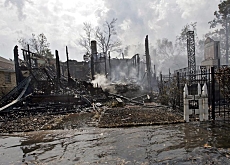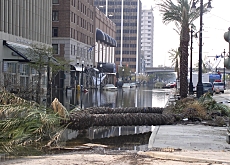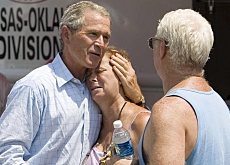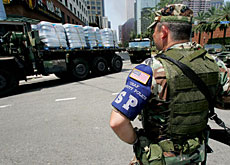New Orleans presents picture of devastation

swissinfo's Adam Beaumont travelled to the city of New Orleans, which was devastated two weeks ago by Hurricane Katrina.
Here he describes his first impressions of the city and the sheer scale of the task that lies ahead.
Travelling southbound along Interstate 10, a steady stream of ambulances, police cars, food-delivery trucks and army vehicles pours towards New Orleans.
Sandwiched among them are residents of the Crescent City, many of them returning for the first time and fearful of what awaits them.
For most of the 130km journey from Baton Rouge, there is little evidence of the deadly hurricane that swept across the states of Louisiana, Alabama and Mississippi two weeks ago.
But as the highway sweeps around the edge of Lake Pontchartrain and into the outer suburbs of New Orleans, the damage wrought by Katrina is impossible to miss.
There are homes with their roofs torn off, warehouses stripped of their walls, giant advertising hoardings collapsed in crumpled piles of twisted metal and fallen trees everywhere – on top of cars, leaning into houses or simply lying where they fell, ripped from the ground by the deadly winds.
As you try to take in the scale of destruction, something else hits you: there is nothing moving in the neighbourhoods on both sides of the road – no people, no sign of life.
Disaster area
My driver, Red Cross volunteer Chris Campbell, has been watching wall-to-wall coverage of the disaster for the past fortnight. But seeing the devastation and the desolation close up is a different matter.
“I could almost cry,” he says. “I never imagined it would look as bad as this.”
Shops and houses are boarded up, and the traffic lights are down all over the city. There’s no electricity. As we pass one street, a ragged sign serves as a vivid reminder of the lawlessness that engulfed the city: “We will shoot drunken looters,” it says in thick red letters.
As we swing into the centre of New Orleans we tag behind a convoy of four black SUVs marked “Sheriff”, pulling off the freeway at the Superdome and dropping down into the city.
Everywhere there is debris. Abandoned cars lie at the side of the road and to the right and left, streets are still under at least a foot of muddy, stinking water. Six army Humvees cross in front of us, before setting off down another flooded street.
We turn towards the French Quarter, passing battered buildings, piles of wreckage and rotting rubbish. You can almost smell the city before you even get to it and in the enclosed streets there is no escaping the heavy stench.
Shattered shop fronts
Along Canal Street, it is difficult to tell who or what was responsible for the shattered shop fronts: the hurricane or the looters. Floodwater laps the windows of semi-submerged cars, while flat-bottomed rescue boats sit beached on pavements.
We turn into Bourbon Street, the once beating heart of the French Quarter and home to the city’s liveliest nightlife. But the jazz clubs, strip joints and daiquiri bars, like the rest of New Orleans, are dead to the world.
Chris can’t stop shaking his head. The former army veteran struggles to take it all in. It’s harder for him because he’s been here before – when the place was alive.
But he can’t hang around. The time is closing in on 4pm and he needs to be out of the city before curfew.
“I’ve done my three years of ducking and dodging bullets,” he says before heading back to Baton Rouge.
No sign of life
On the streets there are only emergency workers, police officers, soldiers and reporters to be seen. Security guards sit outside the few hotels that remain open. Otherwise a city that only two weeks ago was home to 500,000 people is totally devoid of life.
As the sun goes down on the Mississippi, New Orleans is enveloped by a dark shroud. There is no street lighting, and the rumble of a passing patrol and the constant movement of helicopters overhead are the only sounds to fill the night.
Inside the Royal Sonesta Hotel on Bourbon Street, where I spend the night, the staff have had little contact with the outside world. They have not seen a newspaper in a fortnight and they huddle around my copy of Time magazine’s special hurricane edition.
An aerial map shows them for the first time the full extent of the flooding around the city. The hotel’s stand-in chef still can’t believe his luck. He lives in a basement flat and both he and his cat came through the disaster unscathed. Not a drop of water anywhere.
But hundreds of thousands of other residents of New Orleans were not so lucky. Half the city remains under water and it will be many months before they can think of returning home.
swissinfo, Adam Beaumont in New Orleans
President Bush arrived in New Orleans on Sunday for a two-day visit to the Gulf Coast region during which he will for the first time tour the interior of the city devastated by Hurricane Katrina.
Engineers say breaches in the flood defences have been repaired and pumps appear to be lowering the floodwater in residential areas.

In compliance with the JTI standards
More: SWI swissinfo.ch certified by the Journalism Trust Initiative



You can find an overview of ongoing debates with our journalists here. Please join us!
If you want to start a conversation about a topic raised in this article or want to report factual errors, email us at english@swissinfo.ch.